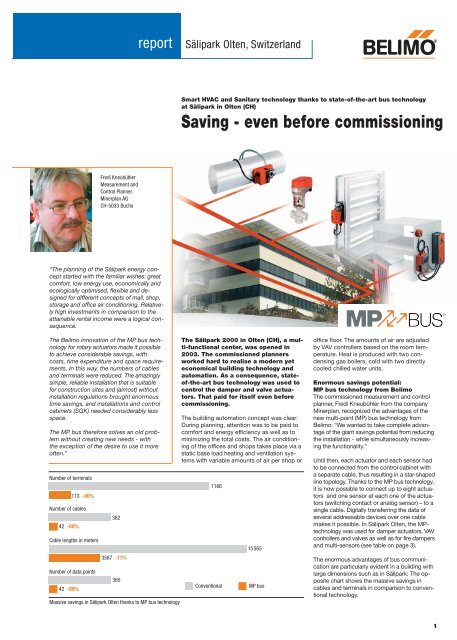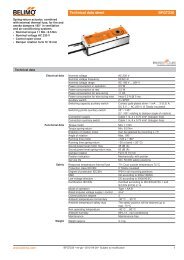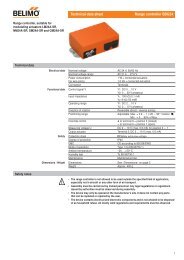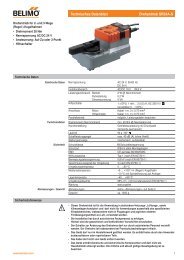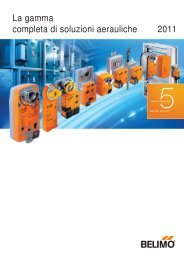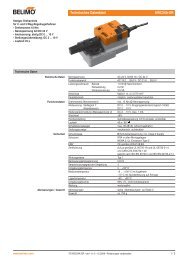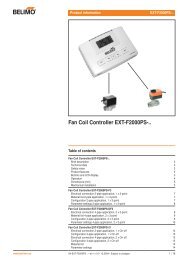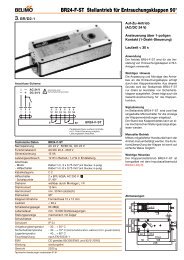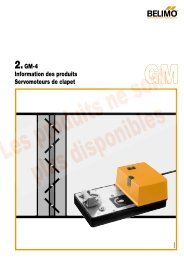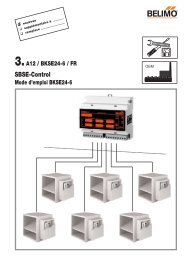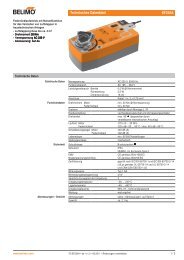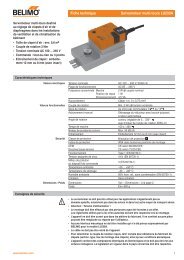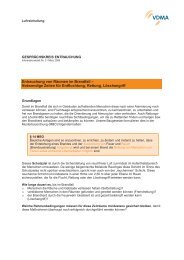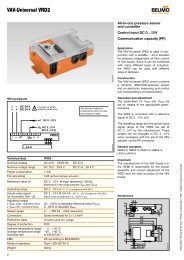information - Belimo
information - Belimo
information - Belimo
You also want an ePaper? Increase the reach of your titles
YUMPU automatically turns print PDFs into web optimized ePapers that Google loves.
eport<br />
Sälipark Olten, Switzerland<br />
Smart HVAC and Sanitary technology thanks to state-of-the-art bus technology<br />
at Sälipark in Olten (CH)<br />
Saving - even before commissioning<br />
Fredi Kneubühler<br />
Measurement and<br />
Control Planner<br />
Minerplan AG<br />
CH-5033 Buchs<br />
“The planning of the Sälipark energy concept<br />
started with the familiar wishes: great<br />
comfort, low energy use, economically and<br />
ecologically optimised, flexible and designed<br />
for different concepts of mall, shop,<br />
storage and office air conditioning. Relatively<br />
high investments in comparison to the<br />
attainable rental income were a logical consequence.<br />
The <strong>Belimo</strong> innovation of the MP bus technology<br />
for rotary actuators made it possible<br />
to achieve considerable savings, with<br />
costs, time expenditure and space requirements.<br />
In this way, the numbers of cables<br />
and terminals were reduced. The amazingly<br />
simple, reliable installation that is suitable<br />
for construction sites and (almost) without<br />
installation regulations brought enormous<br />
time savings, and installations and control<br />
cabinets (SGK) needed considerably less<br />
space.<br />
The MP bus therefore solves an old problem<br />
without creating new needs - with<br />
the exception of the desire to use it more<br />
often.”<br />
Number of terminals<br />
113 -90%<br />
Number of cables<br />
42 -88%<br />
Cable lengths in meters<br />
Number of data points<br />
42 -88%<br />
362<br />
3587 -77%<br />
365<br />
Massive savings in Sälipark Olten thanks to MP bus technology<br />
The Sälipark 2000 in Olten (CH), a multi-functional<br />
center, was opened in<br />
2003. The commissioned planners<br />
worked hard to realise a modern yet<br />
economical building technology and<br />
automation. As a consequence, stateof-the-art<br />
bus technology was used to<br />
control the damper and valve actuators.<br />
That paid for itself even before<br />
commissioning.<br />
The building automation concept was clear:<br />
During planning, attention was to be paid to<br />
comfort and energy efficiency as well as to<br />
minimizing the total costs. The air conditioning<br />
of the offices and shops takes place via a<br />
static base load heating and ventilation systems<br />
with variable amounts of air per shop or<br />
1166<br />
Conventional<br />
15565<br />
MP bus<br />
office floor. The amounts of air are adjusted<br />
by VAV controllers based on the room temperature.<br />
Heat is produced with two condensing<br />
gas boilers, cold with two directly<br />
cooled chilled water units.<br />
Enormous savings potential:<br />
MP bus technology from <strong>Belimo</strong><br />
The commissioned measurement and control<br />
planner, Fredi Kneubühler from the company<br />
Minerplan, recognized the advantages of the<br />
new multi-point (MP) bus technology from<br />
<strong>Belimo</strong>: “We wanted to take complete advantage<br />
of the giant savings potential from reducing<br />
the installation - while simultaneously increasing<br />
the functionality.”<br />
Until then, each actuator and each sensor had<br />
to be connected from the control cabinet with<br />
a separate cable, thus resulting in a star-shaped<br />
line topology. Thanks to the MP bus technology,<br />
it is now possible to connect up to eight actuators<br />
and one sensor at each one of the actuators<br />
(switching contact or analog sensor) – to a<br />
single cable. Digitally transferring the data of<br />
several addressable devices over one cable<br />
makes it possible. In Sälipark Olten, the MPtechnology<br />
was used for damper actuators, VAV<br />
controllers and valves as well as for fire dampers<br />
and multi-sensors (see table on page 3).<br />
The enormous advantages of bus communication<br />
are particularly evident in a building with<br />
large dimensions such as in Sälipark: The opposite<br />
chart shows the massive savings in<br />
cables and terminals in comparison to conventional<br />
technology.<br />
1
eport<br />
Sälipark Olten, Switzerland<br />
Flat cable, high rationalisation<br />
In addition to the massive savings in installation<br />
materials, this also results in considerable rationalization<br />
in planning and installation - enabled<br />
by the special flat cable developed by Woertz<br />
(details on page 3).<br />
The connection cables of the drives and sensors<br />
can be connected with special connectors<br />
that ensure reliable contact with the ribbon<br />
cable, without stripping or screw connection<br />
work having to be done. Thanks to the addressing<br />
of the MP components, these communicate<br />
reliably and bidirectionally with the control<br />
components. Fredi Kneubühler sees this as<br />
the future: “It is not for nothing that different<br />
leading DDC/PLC manufacturers have already<br />
introduced interfaces for the MP bus into the<br />
market.”<br />
More than just control: Building<br />
management<br />
The building automation with DDC controllers<br />
controls all the HVAC and sanitary systems.<br />
However, it does more than that: Further tasks<br />
of the building management system include<br />
detection, processing and saving of fault messages<br />
as well as relevant energy consumption.<br />
In addition to the HVAC systems, the lighting<br />
of the common areas, the release times of the<br />
doors and elevators and the alarm and fault<br />
detection are detected and controlled via the<br />
same system. The system affects the electrical<br />
units via interfaces with higher-level commands<br />
such as group movement commands<br />
for blinds, time commands for electrical doors<br />
etc. The building automation with Pro-MoS NT<br />
as a building management system also allows<br />
a largely personnel-free operation, for example<br />
through the automatic release of the doors.<br />
Programmable logic<br />
controller PLC of the PCD2<br />
series with MP interface<br />
from SAIA-Burgess:<br />
building automation with<br />
the latest technology<br />
System integrator programs in a familiar<br />
environment<br />
In Sälipark, DDC controllers (PCD2) from Saia<br />
Burgess AG with an MP bus interface are<br />
used. In the entire building, only six control<br />
cabinets were installed for the HVAC and two<br />
for the building control system. To the system<br />
integrator, the data points of the <strong>Belimo</strong> actuators<br />
and sensors connected to the MP bus<br />
appear the same as “normal” inputs and outputs<br />
on the engineering tool of the PCD2.<br />
This makes the system integrator’s work considerably<br />
easier, since this person can create<br />
a building-specific application in the usual way.<br />
The higher-level networking of the DDC controllers<br />
on the top network control level is<br />
done with the Saia®S Bus and via Ethernet.<br />
The systems can be operated with only two<br />
PC’s on site. An additional PC with limited<br />
rights is integrated for the ventilation systems<br />
of the leased technical college.<br />
Remote maintenance up to the actuator<br />
and sensor level<br />
The caretaker and system integrator can directly<br />
access the systems via a modem connection.<br />
Since the VAV-Compact controllers<br />
from <strong>Belimo</strong>, which control the VAV units, are<br />
directly integrated in the system in a buscapable<br />
way via the MP bus, the system integrator<br />
can adjust the operating volume of<br />
the VAV units through remote control if needed<br />
- he or she is therefore spared a visit to the<br />
systems.<br />
2<br />
Sälipark Olten (CH) –<br />
A shopping and<br />
air conditioning<br />
experience<br />
The building of Sälipark Olten was realised<br />
in only one and a half years after the<br />
building permit was issued. The result is a<br />
shopping center that supplements the offers<br />
of the existing Sälipark. A shopping<br />
and adventure place was deliberately created<br />
that stands out from surrounding<br />
retail shopping centers as a result of its<br />
extraordinary ambiance.<br />
“Consumption - service - education - health”<br />
is the mixture. In addition to the 18 shops (from<br />
drugstore to discounter, from travel agency to<br />
hairdresser’s), one also finds a medical center<br />
with a dialysis station and a clinic for eye and<br />
plastic surgery as well as classrooms of the<br />
Solothurn Nordwestschweiz college.<br />
A very bright and safe parking garage receives<br />
the customers, who reach the elegant<br />
mall with comfortable escalators. A lot of<br />
visitors do not know this any more: Up until<br />
the last century, there was a foundry on<br />
these premises. All design elements were<br />
developed together with a foundry expert to<br />
connect the modern center with the past.<br />
This creates an aura of rustic luxury in the<br />
spacious mall.<br />
➊
eport<br />
Sälipark Olten, Switzerland<br />
The practical side<br />
People involved in the project experienced<br />
many advantages with the MP bus:<br />
■ A significantly shorter commissioning time<br />
per data point<br />
■ No more mixing up the connection of the<br />
actuators in the control cabinets since they<br />
are automatically identified by software, i.e.<br />
via the MP bus address<br />
■ The same holds true for the sensors<br />
connected to the actuators, since a spatial<br />
relationship between actuator and sensor<br />
is clearly visible on the system<br />
■ As a result of the uniform connections of the<br />
bus users, the number of possible fault<br />
sources is reduced – regardless of the connected<br />
damper and valve actuators, VAV<br />
controllers and sensors<br />
■ A significant reduction in the time expended<br />
per actuator and sensor connection point<br />
when the multi-bus ribbon cable is used instead<br />
of conventional branch connectors<br />
■ Remote-control access of the integrator<br />
from his or her office to the system PC, for<br />
example to adjust Vmin. and Vmax. of the<br />
VAV units<br />
■ Simplified extension of the system: An<br />
electrician can, for example, install an additional<br />
sensor and connect it to the nearest<br />
MFT2 actuator, and the integrator can<br />
activate this from his or her office: this eliminates<br />
the cabling expense, among other<br />
things<br />
Devices that are integrated via 42 MP bus lines at<br />
Sälipark Olten:<br />
Device:<br />
Number<br />
Fire damper actuators 82<br />
VAV controllers 74<br />
Damper actuators 25<br />
Valve actuators 51<br />
MP multi-sensors 12<br />
Passive and active sensors<br />
(connected via the actuators) 92<br />
Total integrated MP devices 336<br />
The bus future has begun<br />
“The more intelligent bus technology becomes<br />
established with its potential for minimising<br />
costs while maximising functionality, the<br />
more frequently buildings can be built with a<br />
higher standard of equipment” Kneubühler<br />
sees for the future, “this is an advantage for<br />
users, who enjoy more comfort, and for<br />
builders and operators, who profit from more<br />
efficient maintenance.”<br />
<strong>Belimo</strong> MP bus techno-<br />
technology at a glance at a<br />
glance<br />
MP stands for Multi Point. The MP bus is<br />
the <strong>Belimo</strong> master/slave bus. Up to 8<br />
slaves can be connected to a master<br />
unit. MFT2 damper actuators, MFT2 valve<br />
actuators and VAV-Compact controllers.<br />
Advantages include considerably reduced<br />
wiring expenses, a clearer arrangement,<br />
substantially higher functionality and cost<br />
savings as well. Up to eight MFT2 actuators<br />
can be controlled by an MP master<br />
via the MP bus. MP masters are PLC or<br />
DDC controllers with MP interface or<br />
<strong>Belimo</strong> “gateways” to fieldbus systems<br />
such as LonWorks or EIB/Konnex.<br />
Sensor connection: One conventional<br />
sensor such as for example a temperature<br />
or moisture sensor or a switch can<br />
be connected per MFT2 actuator. The<br />
analog signals of the sensors are digitized<br />
via the MFT2 actuators and transferred<br />
to the MP master via the MP bus. In this<br />
way, conventional sensors can be made<br />
directly MP-, EIB/Konnex- or LonWorkscapable.<br />
The MP I/O module UST-3<br />
makes it possible to directly connect additional<br />
sensors via the MP bus or to<br />
operate devices that require conventional<br />
control. (For details on MP bus technology,<br />
see www.belimo.ch)<br />
This requires all people involved to think beyond<br />
individual systems, however. When<br />
HVAC/building automation planners and system<br />
integrators, electrical planners and installers<br />
work together efficiently, a win/win<br />
situation is created for all those involved.<br />
Source: Richard Staub, Elektrotechnik 11/03<br />
www.bus-house.ch<br />
Efficient installation: Ribbon cable<br />
The wiring of an MP bus system does not<br />
require either special cables or terminating<br />
resistors. The multi-bus ribbon cable from<br />
Woertz is just the right thing for efficient installation,<br />
however. The connection between<br />
the Woertz ribbon cable and the round cable<br />
for MFT2 actuators, for which a patent application<br />
has been filed, allows an efficient, interference-free<br />
wiring. The preassembly can<br />
be done in the factory and saves time and<br />
money. The final assembly at the construction<br />
site is done with a simple click on any point<br />
of the ribbon cable.<br />
MP bus line topologies<br />
There are no limitations for the line topology.<br />
Star-shaped, ring-shaped, tree-shaped or<br />
mixed forms are permitted.<br />
➋<br />
Key elements of the MP bus technology (from left to right):<br />
➊ Actual value displays of the air volumes for VAV controllers as well as the corresponding temperatures, shown in the building<br />
management system. Easily realizable through direct digital access to the VAV controllers and temperature sensors via MP bus<br />
➋ Air conditioning plant: damper actuators and sensors on the MP bus<br />
➌➍ VAV controllers, damper actuators, valve actuators and sensors on a common MP ribbon cable line<br />
➌<br />
➍
eport<br />
Sälipark Olten, Switzerland<br />
Key people for the MP bus installation<br />
in Sälipark Olten (CH), from left to right:<br />
Thomas Heini, System Integrator, Renergy;<br />
Markus Keel, Product Manager, <strong>Belimo</strong>;<br />
Fredi Kneubühler, Measurement and Control<br />
Planner, Minerplan<br />
Roland Studer,<br />
Director of Service<br />
Real Estate,<br />
Sälipark Olten<br />
Three questions for Roland Studer:<br />
To be honest, how did you react when you<br />
first heard about the concept of the MP bus<br />
technology for controlling the valve and<br />
damper actuators?<br />
“Actually, I was a bit skeptical at first. The<br />
concept seemed to be almost too easy to be<br />
true. However, when I heard about the success<br />
with the five objects that had already been<br />
realized with the MP bus, I could not say anything<br />
more against it. On the contrary!”<br />
Can you give us any concrete numbers on<br />
the effective savings as a result of the MP bus<br />
solution?<br />
“Without divulging any company secrets, I<br />
can mention the following cost savings in<br />
comparison to a conventional installation:<br />
over CHF 11000,00 for equipment, around<br />
CHF 60 000,00 for installations and another<br />
approx. CHF 5000,00 for commissioning.<br />
MP bus technology allows us to save 16% of<br />
the total sum of the measurement and control<br />
and electrical costs!”<br />
Sälipark Olten has been in operation since<br />
March 26, 2003. How has the whole energy<br />
concept stood up, and how satisfied are you<br />
with the MP bus control of the rotary actuators?<br />
MFT2 actuators from<br />
<strong>Belimo</strong> with MP bus<br />
Actuators with Multi-Functional<br />
Technology<br />
At first glance, the MFT2 actuators do not<br />
differ much from conventional types: They<br />
are just as easy to install, wire up and operate.<br />
The main differences lie under the<br />
housing:<br />
A digital control system with integral MP<br />
bus gives the actuators a communications<br />
capability together with a whole range of<br />
extra functions. MFT2 actuators allow a<br />
wide variety of system components such<br />
as air control dampers, VAV units, fire<br />
dampers, globe valves and sensors to be<br />
linked together at very low cost and to<br />
be economically integrated in the building<br />
and room automation.<br />
Up to eight MFT2 actuators can be coupled<br />
together via the MP bus and connected<br />
to a DDC controller with MP bus interface<br />
(e.g. SAIA PCD2) or via a gateway to a<br />
LonWorks® or EIB/Konnex network (gateway<br />
for LonWorks = UK24LON, gateway<br />
for EIB/KNX = UK24EIB). One conventional<br />
sensor such as e.g. a temperature or moisture<br />
sensor or a switch can be connected<br />
per MFT2 actuator. The MFT2 technology<br />
digitalizes the analog signals of the sensors<br />
and integrates them into the <strong>Belimo</strong> MP bus<br />
via the actuator cable.<br />
The MFT2 actuators not only receive commands<br />
but also transmit detailed <strong>information</strong>,<br />
for example the actual damper position,<br />
the state of the actuators etc, to the top<br />
network control level.<br />
To sum up: The MP bus technology enormously<br />
reduces the cabling effort and simultaneously<br />
increases the functionality.<br />
The <strong>Belimo</strong> Group<br />
<strong>Belimo</strong> is a worldwide leading supplier for<br />
innovative electrical actuator solutions in<br />
the field of heating, ventilation and air conditioning<br />
systems. Their headquarters are<br />
in Hinwil, Switzerland. The Group achieved<br />
a sales turnover of around CHF 240 million<br />
in fiscal year 2003 and employs a workforce<br />
of over 700. <strong>Belimo</strong> is represented in<br />
60 countries worldwide. For further <strong>information</strong><br />
on the company and its products,<br />
visit the website at: www.belimo.ch<br />
∆ p<br />
MP bus - the 3-pin actuator and<br />
sensor bus.<br />
Communication and power supply<br />
in the same cable<br />
Code 01/04 Subject to technical modifications<br />
“The specifications comprise a number of<br />
different concepts: individual air conditioning<br />
in the shops, single-room control in offices,<br />
ground water heating pump, ground water<br />
cooling and thermoactive building systems<br />
(component conditioning). The entire energy<br />
concept has optimally stood the test - naturally<br />
the MP bus technology as well. All the<br />
involved people, planners, integrators and<br />
<strong>Belimo</strong> deserve congratulations for this.”<br />
For more detailed <strong>information</strong>, please contact your <strong>Belimo</strong> representative:<br />
<strong>Belimo</strong> Automation AG, Brunnenbachstrasse 1, 8340 Hinwil, Switzerland, Tel. +41 (0) 43 843 61 11, info@belimo.ch, www.belimo.ch<br />
4


